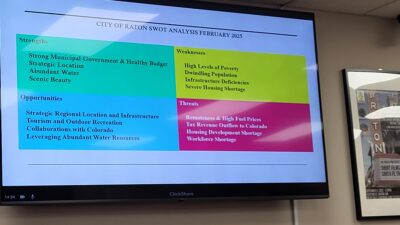by Eric Mullens
 WALSENBURG — Approximately 60 residents of Walsenburg and Huerfano County attended a City of Walsenburg sponsored work session Feb. 10 to hear presentations concerning the county’s request to the city to vacate W. Fifth Street for construction of a new judicial center facility.
WALSENBURG — Approximately 60 residents of Walsenburg and Huerfano County attended a City of Walsenburg sponsored work session Feb. 10 to hear presentations concerning the county’s request to the city to vacate W. Fifth Street for construction of a new judicial center facility.
The nearly two-hour long work session was held at the Huerfano County Community Center in Walsenburg and the majority of audience questions concerned potential traffic flow issues.
Those attending the meeting heard presentations from Third Judicial District Senior Judge Claude Appel, Huerfano County Sheriff Bruce Newman, Huerfano County Administrator John Galusha, Third Judicial District Court Administrator Bob Kreiman, Nan Anderson of Anderson/Hallas Architects and Walsenburg Mayor James Eccher.
Both Mayor Eccher and Sheriff Newman told those attending, if they had further questions both officials would be happy to meet with anyone in one-on-one sessions.
Judge Appel and Sheriff Newman both spoke on the issue of security. This item has been the most noticeable in the proposal for a new judicial center, as many residents of Walsenburg are aware inmates from the county jail are currently escorted across the street from the jail to the county courthouse by sheriff’s deputies for various court appearances. Judge Appel however expanded on the theme of security, and limited space, on the top floor that houses the county and district judicial portion of the historic building. He said the issue inside of the building proves problematic with victims, defendants, witnesses, potential jurors and others being crowded together in the small lobby outside of the courtrooms.
Judge Appel also talked about the general condition of the 100-year old building, mentioning leaks in ceilings, a crumbling exterior which some years ago caused a trial to be moved to the municipal courtroom at Walsenburg City Hall, and led to the judge suing the county commissioners to make necessary exterior repairs as portions of the building dropped in front of the main entrance. He also talked about necessary ADA compliance issues, restroom issues and limited space for county offices.
Anderson said building design, materials and location of the actual courtrooms in a new building would address the issue of train noise, though designers doubt it could be eliminated entirely.
Appel and Newman’s comments regarding security and other needs were clearly understood and embraced by those attending the work session, but traffic concerns remained the priority of residents and downtown business owners.
Those presenting at the mid-week session said a traffic study was part of the next steps in the process. Although Kreiman said he would appreciate specific concerns about traffic be made, to enhance the results of a traffic study.
A proposal to establish a truck route east on Seventh Street to Russell Avenue for access to Colorado Hwy 10 is being discussed.
How will the project be paid for:
The early plans call for utilization of grants and loans; $2M in Energy Impact Grants; $1M from Underfunded Facilities; $5.2M in county marijuana excise taxes (over a 10-year period); $1.5M in USDA grants/loans for a total of $9.7 million. Galusha and Appel both said if funds become tight, the estimated cost of $1,415,500 courthouse rehabilitation could be put off for an unspecified time period.
Eccher told the World Journal this week, “We have the same concerns as citizens, I believe, if we do vacate it we would have to put in conditions to any vacation action.” He said those conditions would likely say the vacation of the street would only physically happen after financing was in place, and traffic and utilities studies were completed.
He said the vacation could be approved by city council, but would not take effect until actual construction was scheduled to begin. He said that could be two to four years in the future.
Appel and Galusha also responded to questions regarding how the current concept location was decided upon. They explained how the project task force had explored options including the top floor of the library in Walsenburg, Washington School and the empty Corrections Corporation of American-owned prison site.
While the prison would seem a natural fit for a secure judicial center, and any future county jail expansion, it was explained the property owner would not lease office space nor consider a purchase offer or lease of the entire prison facility.
They also considered the former St. Mary School, but the buildings and grounds are now privately owned.





